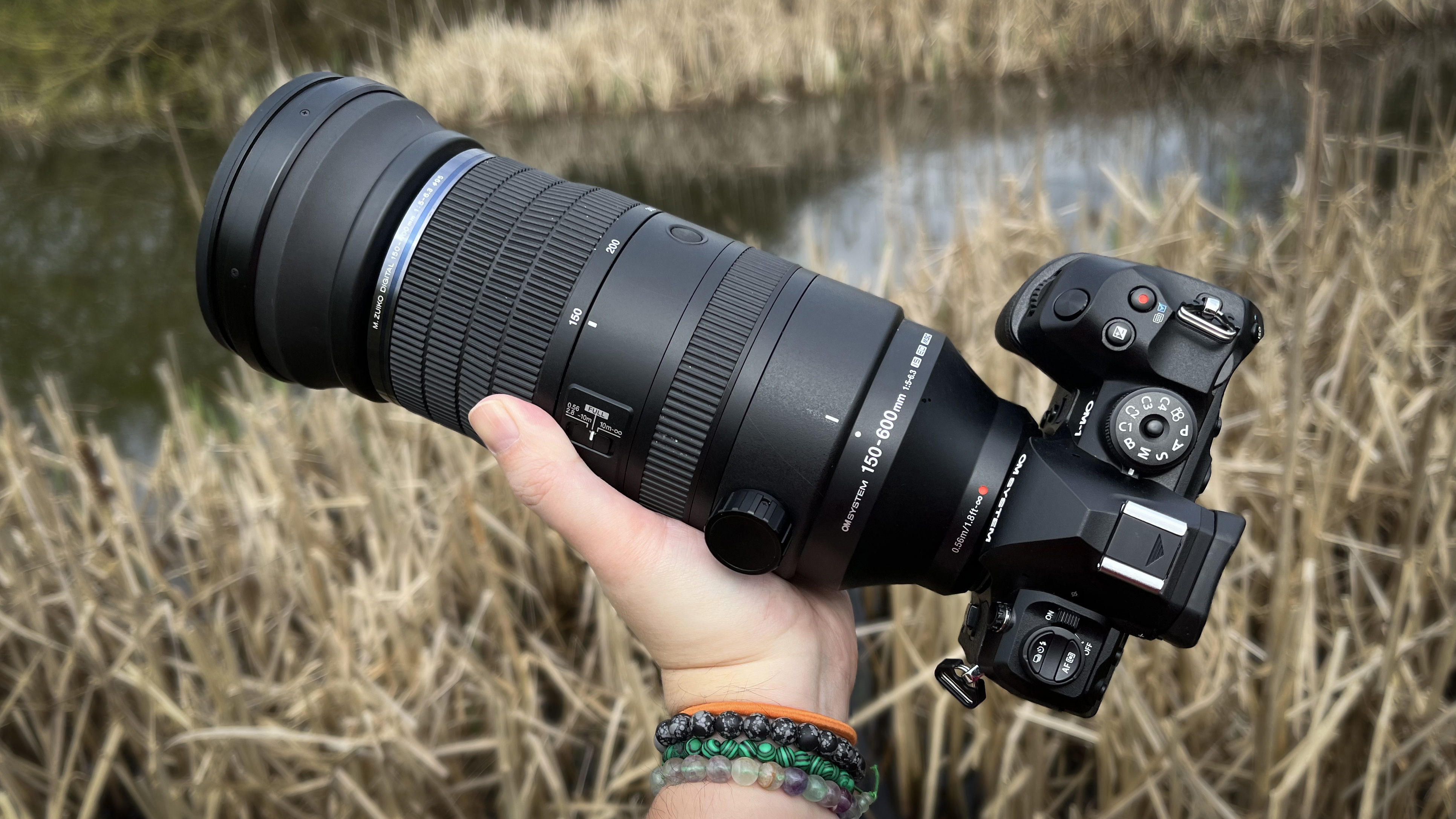
With OM Digital Solution’s shift in emphasis to consider itself more of an outdoor equipment company that specializes in imaging equipment, the M.Zuiko 150-600mm f/5.0-6.3 IS clearly fits with the new strategy. Effectively a 300-1200mm, thanks to the crop factor of the Micro Four Thirds sensor, it’s very much suited to ‘outdoorsy’ applications and subjects – wildlife, birds, sports, adventure activities, aircraft and sailing.
To further strengthen its outdoor credentials, the 150-600mm is weather-sealed to the IPX1 standard for handling moisture and dust. Additionally, the exposed surface of the front element has a fluorine coating to help better repel water and grease, but also make it easier to clean.
The IPX1 standard isn’t as exacting as the IP53 tests that the top-end OM System camera bodies have to pass, but it’s still good and there are fewer potential entry points on a lens so there’s no reason why it wouldn’t hold up over a period of time when shooting in wet or dusty conditions. However, it is worth noting that recent OM System lenses such as the 90mm f/3.5 Macro and the 40-150mm f/4.0 Pro are rated to IP53 for protection. The 150-600mm is marked ’Splash Proof’, which is probably your best guide to how wet it can get over a prolonged period of time.
Much has been made elsewhere about the OM System model’s similarity with the Sigma 150-600mm f/5-6.3 DG DN OS Sports, made for Sony FE and L-mount full-frame mirrorless cameras. The OM System lens’ box is marked ‘Made In Japan’, but as OM doesn’t have any manufacturing facilities in Japan it’s quite likely that Sigma is the source. However, while many of the key specs and design features are quite similar, there are some variations – so the two lenses certainly aren’t identical, and it isn’t just a rebranding job.
It would be very surprising if OM Digital Solutions hasn’t had some input – particularly as far as the optical design is concerned, but obviously also the lens’ CPU – and given Sigma’s reputation for building very fine lenses, the association is no bad thing. The key point here is that a lens originally designed for a full-frame mirrorless system is inevitably going to be bulkier than one that’s designed from the ground up for Micro Four Thirds cameras.
The optical image stabilization will potentially give up to 6 stops of correction for camera shake at 150mm and 5 at 600mm, adjusting for pitch and yaw movements. With Sync IS, which works in tandem with the in-body stabilization on (select) cameras, there’s 5-axis movement and the correction for camera shake is quoted at up to 7 stops at 150mm and 6 at 600mm.
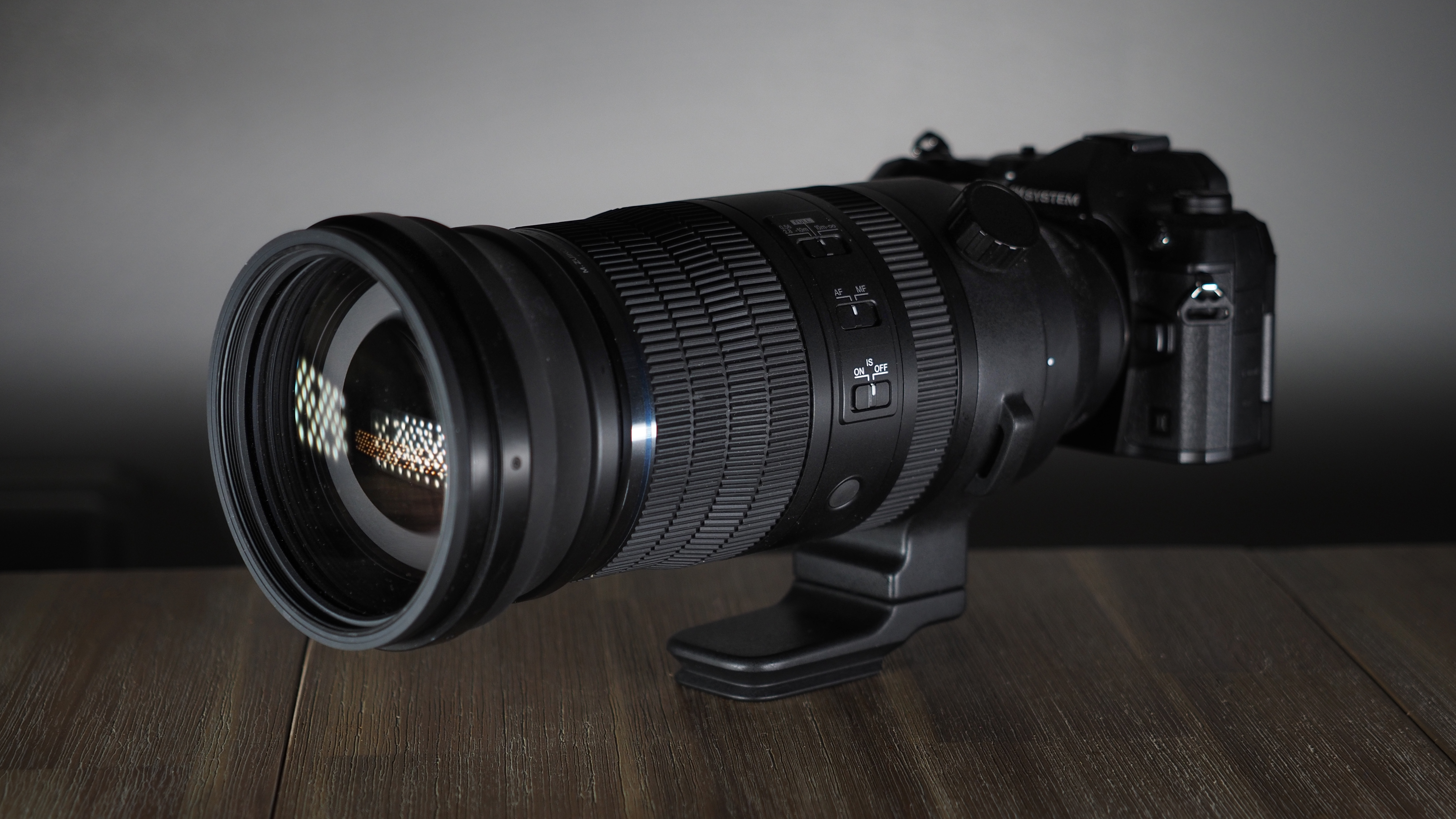
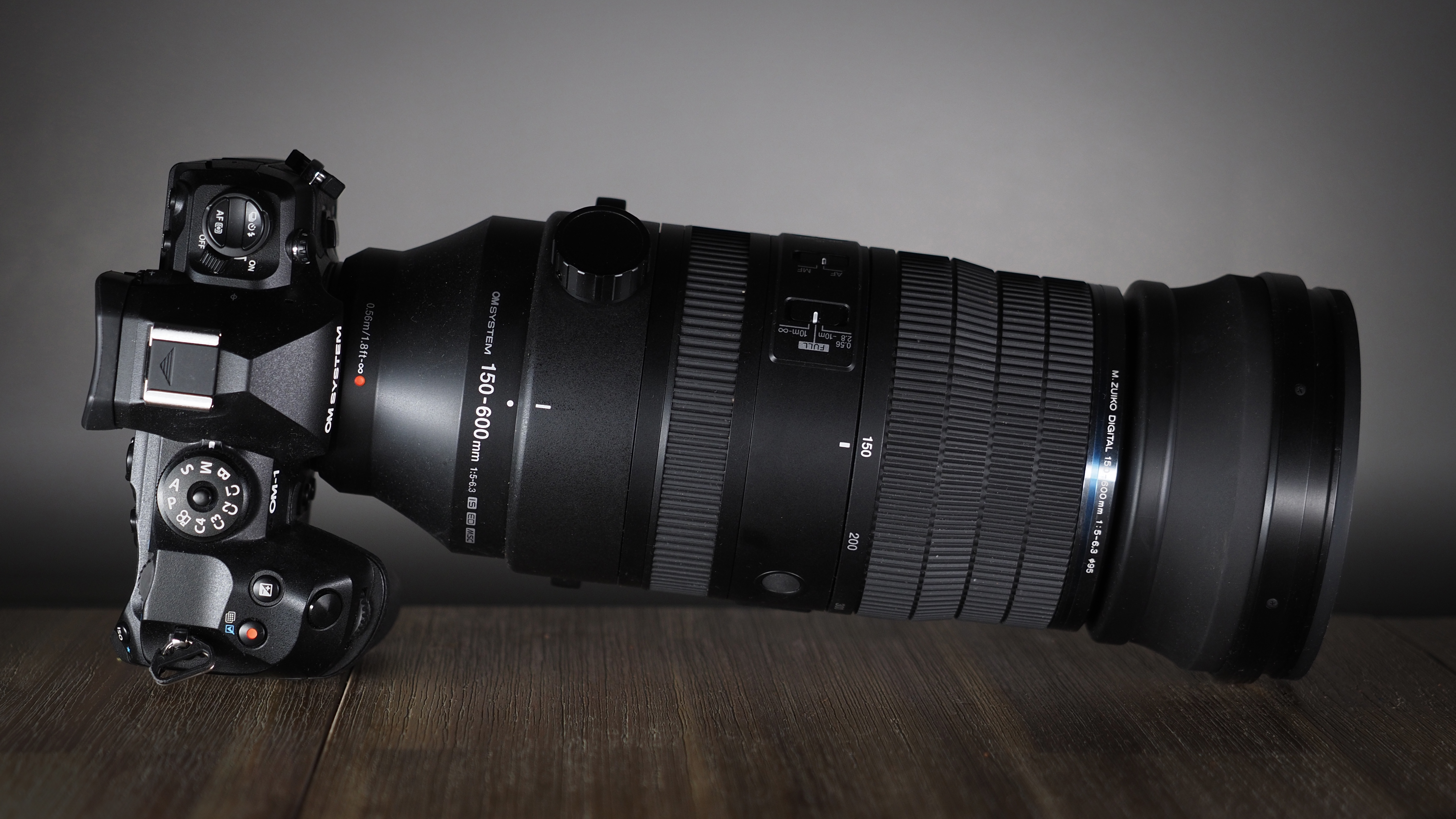

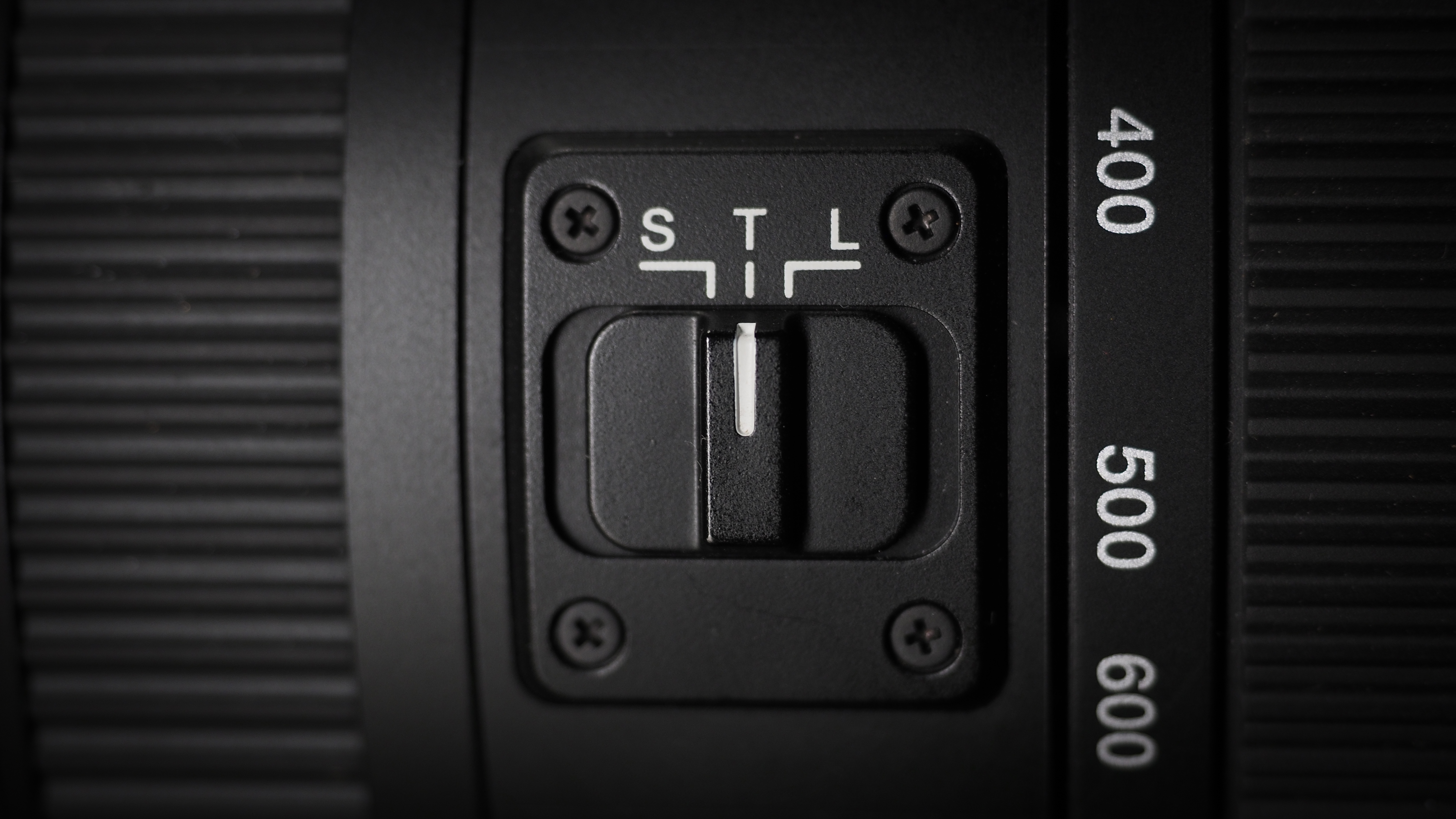
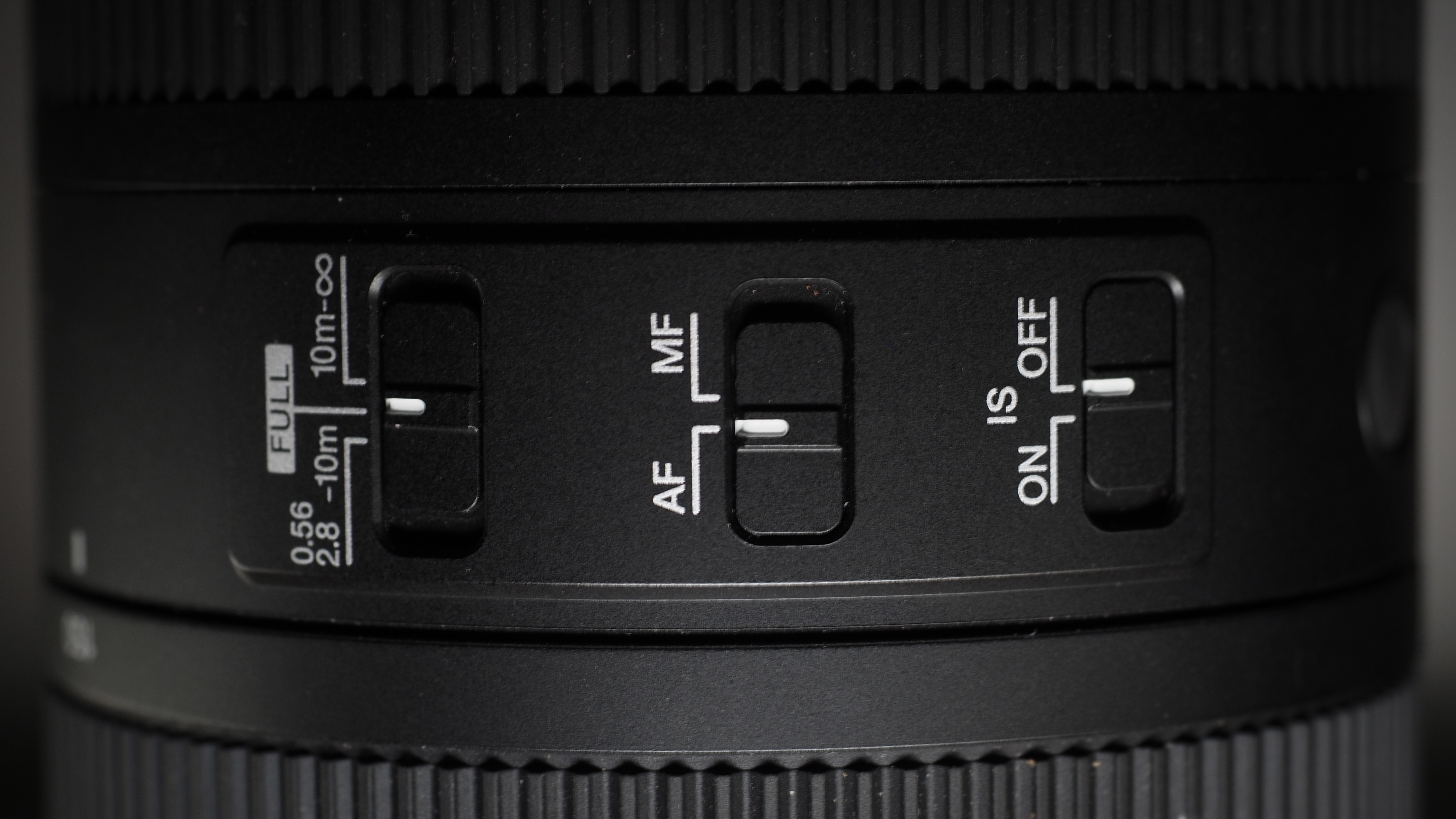

OM System M.Zuiko 150-600mm f/5.0-6.3 IS: Specifications
OM System M.Zuiko 150-600mm f/5.0-6.3 IS: Price & Availability
The OM System M.Zuiko 150-600mm f/5.0-6.3 IS is widely available in all regions, carrying a retail price of $2,699 / £2,499 / AU$4,499. This makes it one of the brand's most expensive lenses, behind only the 150-400mm f/4.5 TC1.25x IS Pro ($7,499 in the US) and 300mm f/4 IS Pro ($2,999 in the US).
It is widely understood that the lens is made by Sigma, modeled after the full-frame Sigma 150-600mm F5-6.3 DG DN OS | Sports for Sony E and L-Mount, which sells for a much lower $1,499 in the US – so there is a premium on the OM-branded version.
Design
There’s a total of 25 elements at work inside the 150-600mm, and they’re arranged in 5 groups with no fewer than 13 special types to correct for distortion, aberration, and to optimize sharpness. The rollcall here is six elements with extra-low dispersion characteristics – four Super ED (Super Extra-Low Dispersion) types and two ED (Extra-Low Dispersion) types – another six HR which are (High Refractive Index) types, and one HD (High Definition) type.
These ED and HR elements are designed to more precisely control how the different colored wavelengths of light pass through them – remembering that refraction or bending takes place as the rays both enter and leave an element – in order to minimize both lateral and longitudinal (axial) chromatic aberrations as well as spherical aberrations.
This a lot of optical correction that is, as we’ve seen with some of the brand’s other lenses, a feature of OM System designs, even when software correction is also applied. Correction profiles – for distortion and chromatic aberrations, for example – are actually built into OM System lenses and applied to JPEGs as they’re processed in-camera (and embedded in RAW images).
There’s no provision for manual intervention here (even with RAW files it’s mostly a take-it or leave-it scenario) so it’s likely thaht OM’s engineers are balancing both to varying degrees to get the best possible result. Certainly the optical correction is doing a lot of the heavy lifting, which is advantageous, and this looks to be where the lens’ optical design has been tweaked for imaging onto the smaller-size sensor.
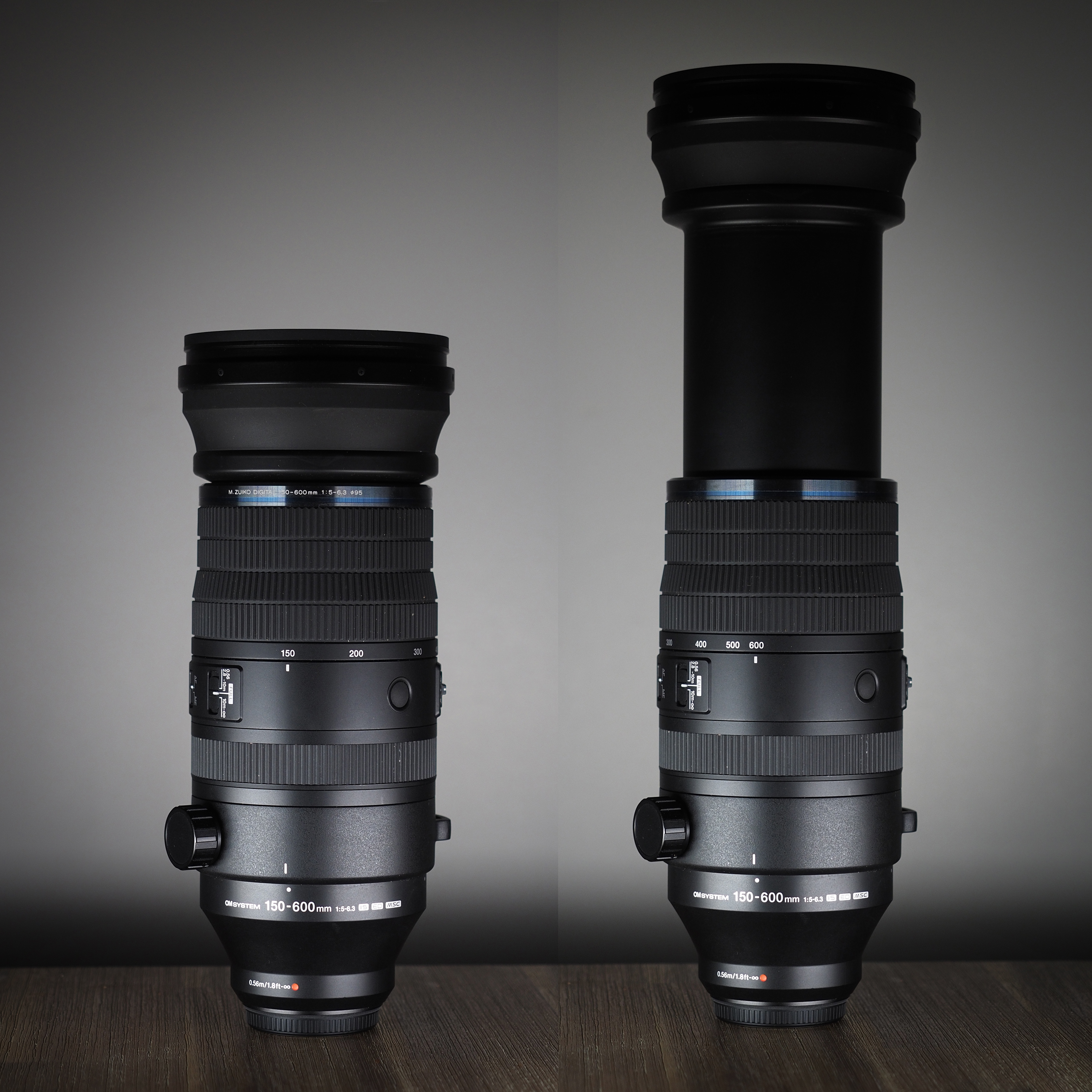
The anti-reflection multi-coating uses OM’s ‘Z Coating Nano’, which was introduced back in the Olympus days with the 300mm f/4.0 IS Pro and uses nanotechnology (which is the basis of many ultra-thin coating products). In OM System lenses, the anti-reflection coating is applied to the surfaces of individual elements to suppress ghosting and flare.
To deal with contra-jour light, the 150-600mm is supplied with a very substantial lens hood and it’ll also protect the front of the lens if you don’t want to invest in a screwthread filter for this job… the fitting is 95mm, so nothing is cheap at this wide a diameter.
The 150-600mm’s autofocusing drive is a high-torque stepping motor that supports the 25fps continuous adjustment available with the OM-1 models. It also employs a magnetic sensor, to precisely determine the focusing group’s position, so the AF system stops as rapidly as it starts – which means it’s both fast and accurate.
The minimum focusing distance is 0.56m at 150mm and extends to 2.8m at 600mm, which respectively gives maximum reproduction ratios of 1:2.8 and 1:5 (full frame equivalents). This represents pretty decent close-up capabilities overall, but at 150mm (which is 300mm effective) it’s extremely good, giving a reproduction size that’s just slightly larger than one-third life size.
The aperture diaphragm has nine blades to give rounder, smoother, out-of-focus effects. And given that the depth-of-field is shallow from the get-go with this zoom, a clean and uniformly soft rendering of the backgrounds is important.
Should 300-1200mm still not be enough reach for you, 150-600mm is compatible with the Olympus-era MC-14 and MC-20 teleconverter. The 1.4x unit gives you 210-840mm, which is effectively 420-1680mm, and the 2.0x creates 300-1200mm, so you’ll have an equivalent 600-2400mm on hand! Whether you’ll still be able to handhold the lens at these massive focal lengths is debatable, but they’re there if you want them (albeit with a progressive loss of lens speed).
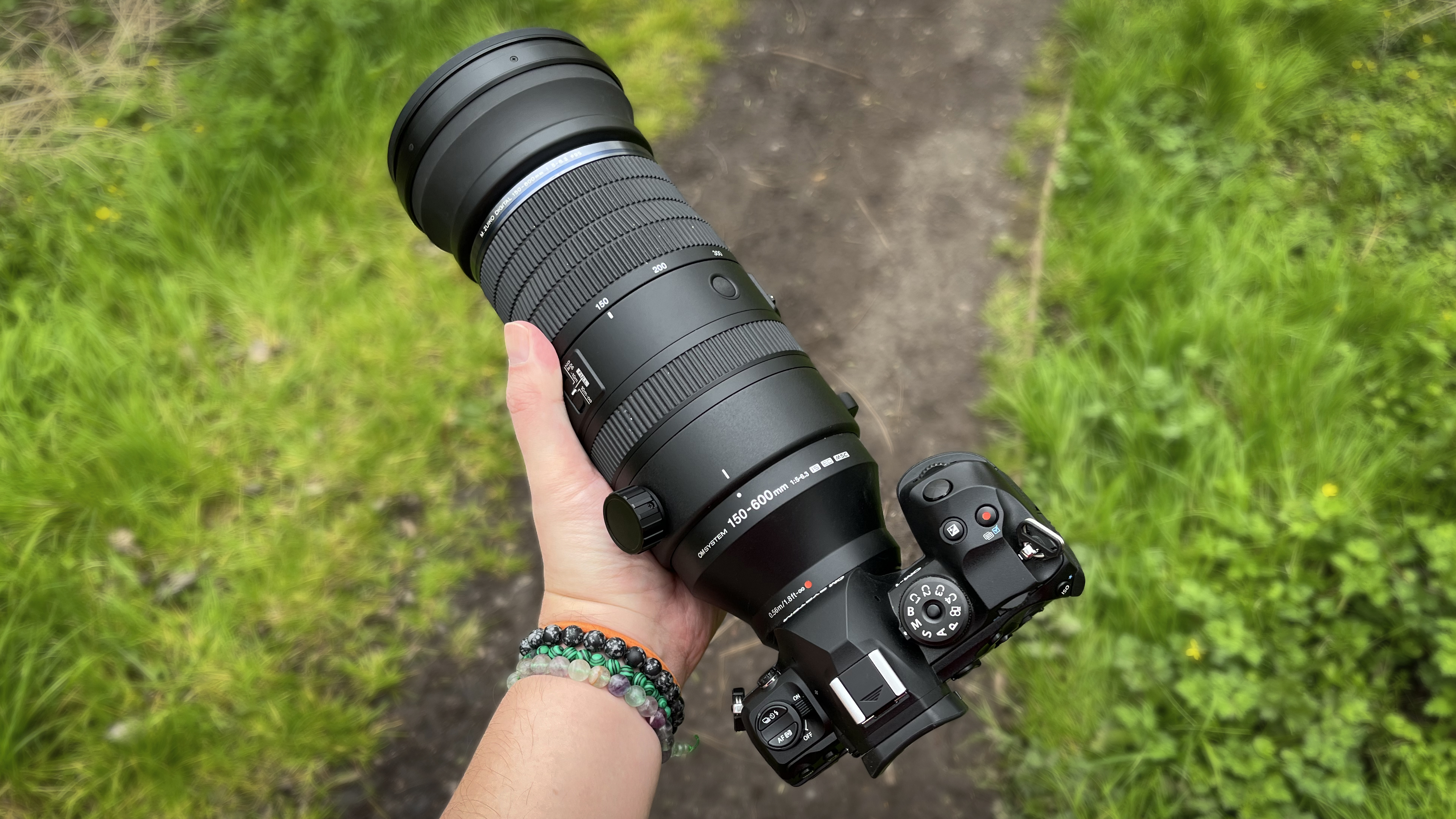
Even by full frame mirrorless system standards, the OM System 150-600mm is a big lens, and all that glassware inside means it tips the scales at over 2 kilograms. And that’s even with the external construction comprising a mixture of lightweight magnesium alloy and high-grade polycarbonate materials.
Consequently, it’s currently the heaviest lens in the M.Zuiko line-up, but also the longest in either zooms or primes. If you know that you’re not going to use it, the tripod collar’s mounting plate can be detached to give a small reduction in the overall weight (the whole collar can’t be removed). The zooming collar is at the front of the lens, which ensures that the handling stays reasonably well-balanced even when the zoom is fully extended. The zooming mechanism is telescopic so, at 600mm, the overall length increases by close to 100mm.
The zooming is marked at 150mm, 200mm, 300mm, 400mm, 500mm and 600mm, and you can change focal length by either twisting this control or by pulling and pushing the inner barrel, trombone-style. Both actions can be switched between Smooth or Tight operation, and the tension switch also has a lock setting that prevents zoom ‘creep’ when you’re carrying the lens.
The Tight setting is actually pretty tight, so zooming requires a concerted twist or shove to get things happening, and it’s a bit hard to see why you’d choose this over the smooth option – especially in situations where speed is the essence. However, it will prevent zoom creep at focal length settings other than 150mm (which is where the zoom lock is applied) so your framing won’t shift when you’re moving around. The Smooth setting – essentially looser – still feels nicely weighted and allows for plenty of precision when it comes to fine-tuning the framing.
The other on-barrel controls comprise the optical image stabilizer’s on / off switch, the AF / MF switch, a focus limiter selector, and a trio of programmable L-Fn function buttons. The focus limiter splits the focusing range in half – minimum focus to 10m or 10m to infinity – plus a full range setting. The L-Fn buttons are collectively assigned from the body, so all three will do the same thing, but there’s a huge choice of 40 assignable functions from the OM-1 Mark II. The default is an AF lock.
The focusing collar is an electronic ‘fly-by-wire’ affair, but it feels fine – albeit with the usual issue that there are no hard stops at either end of the distance range, so you need to watch what’s going on in the viewfinder. This is when the focus peaking display works so effectively, making it very easy to see what’s in focus and what isn’t.
OM System M.Zuiko 150-600mm f/5.0-6.3 IS: Build & Handling
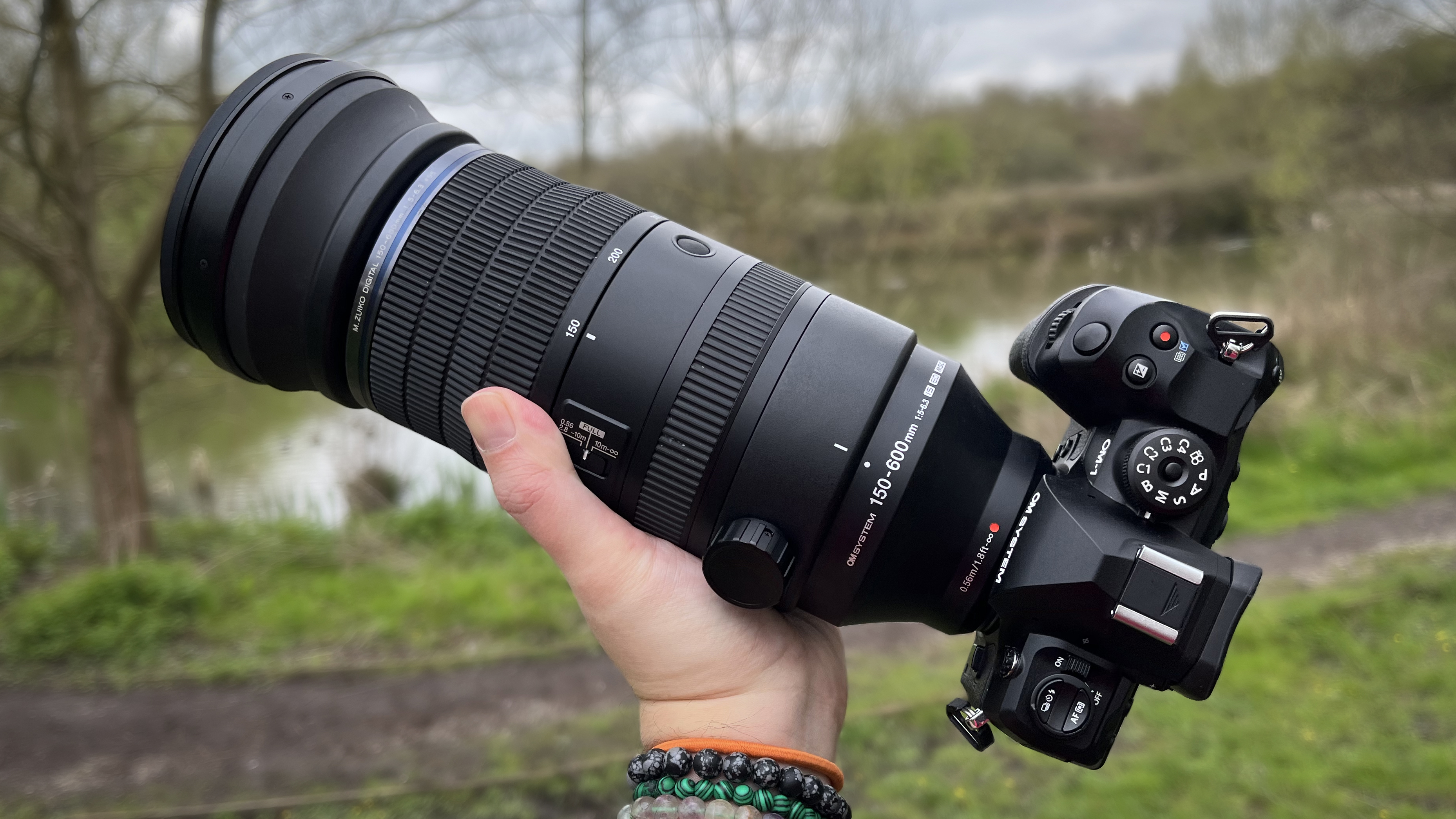
The 150-600mm can definitely be used handheld, but at 2kg plus the camera weight (which is very close to 600g with the OM-1 Mark II) it’s definitely also quite a handful. You will start to feel the strain with longer periods of usage, especially if you’re continually pointing skywards to shoot birds or aircraft.
That said, handheld is arguably the most convenient way to use this lens, especially at the effective 1200mm when the angle-of-view is a mere 2.1° – which can make finding your subject a bit of a challenge. This is even more the case when the subject is quite small in the viewfinder, but with the enhanced maneuverability of handholding it’s much easier to fine-tune your aim.
If you need to use a tripod then a ball-type head is the best option, slackened off so you can move the lens around more easily. In practice, starting at a shorter focal length to assist with locating your subject in the viewfinder and then zooming in to the desired framing works pretty efficiently. With the OM-1 Mark II, the subject recognition AF then kicked in and stayed locked onto the subject, but you do need a very steady hand at the ultra-long focal lengths to make sure you keep the subject within frame.
Handheld shooting also means that you need to keep an eye on the shutter speeds, even with the image stabilizers doing their collective thing with Sync IS. Of course, in many situations (such as sports or wildlife photography) fast shutter speeds will be needed anyway – so it’s going to be more about juggling the apertures. This is particularly beneficial with sports, where very fast shutter speeds and maximum depth-of-field are often needed.
OM System M.Zuiko 150-600mm f/5.0-6.3 IS: Performance

With so many elements and so many air-to-glass boundaries, there’s plenty of challenges when it comes to optical performance – especially sharpness – but the 150-600mm zoom does a commendably solid job across the focal and aperture ranges. (While this was my experience in the field, our lab testing below found the results somewhat less inspiring.)
It helps that the maximum aperture range is f/5.0-6.3, so depth of field is already helping things along, but this is a very sharp lens with good uniformity across the frame even at 600mm – although some slight softening can be noticeable at the corners. They sharpen up nicely when stopping down, and this only needs to be to f/8.0. The sort of subjects that you’re likely to be shooting with this lens – such as birds and wildlife – often have plenty of fine detailing, but feathers and fur are beautifully reproduced with plenty of definition and pleasing crispness.
Perhaps not so surprisingly, the uniformity of brightness across the frame is excellent and there’s negligible vignetting even when shooting at the largest apertures. The optics are also nicely contrasty, and flare is well suppressed in most situations, but there’s a big expanse of front element just waiting to catch some stray rays, so using the hood will prevent any issues here.
Despite the hood’s protective role, it’s probably still worth considering a UV filter because atmospheric haze can diminish contrast when you’re shooting subjects that are a fair distance away. I didn’t experience this, as I was mostly shooting in clear winter air in the mountains, but in summer or nearer urban areas it’s likely that some loss of contrast will be noticeable.
Distortion? There isn’t any, and this is the same for chromatic aberrations or coma – which, to be frank, is to be expected when this lens is only using the cropped central area of its optics.
As noted, I tested the 150-600mm with the OM-1 Mark II – and on this body the AF performance was snappily fast at the shortest focal lengths, and only marginally slower at the longest end (it would be the same on the original OM System OM-1, too). The tracking is pretty reliable at 25fps (remember, though, that 50fps is supported by the likes of the 300mm f/4.0 and the 150-400mm f/4.5 TC 1.25x) and should you lose the subject from the frame momentarily – which isn’t hard to do at 1200mm – the subject detection modes will re-acquire it very quickly, so you really can’t miss.
OM System M.Zuiko 150-600mm f/5.0-6.3 IS: Sample images



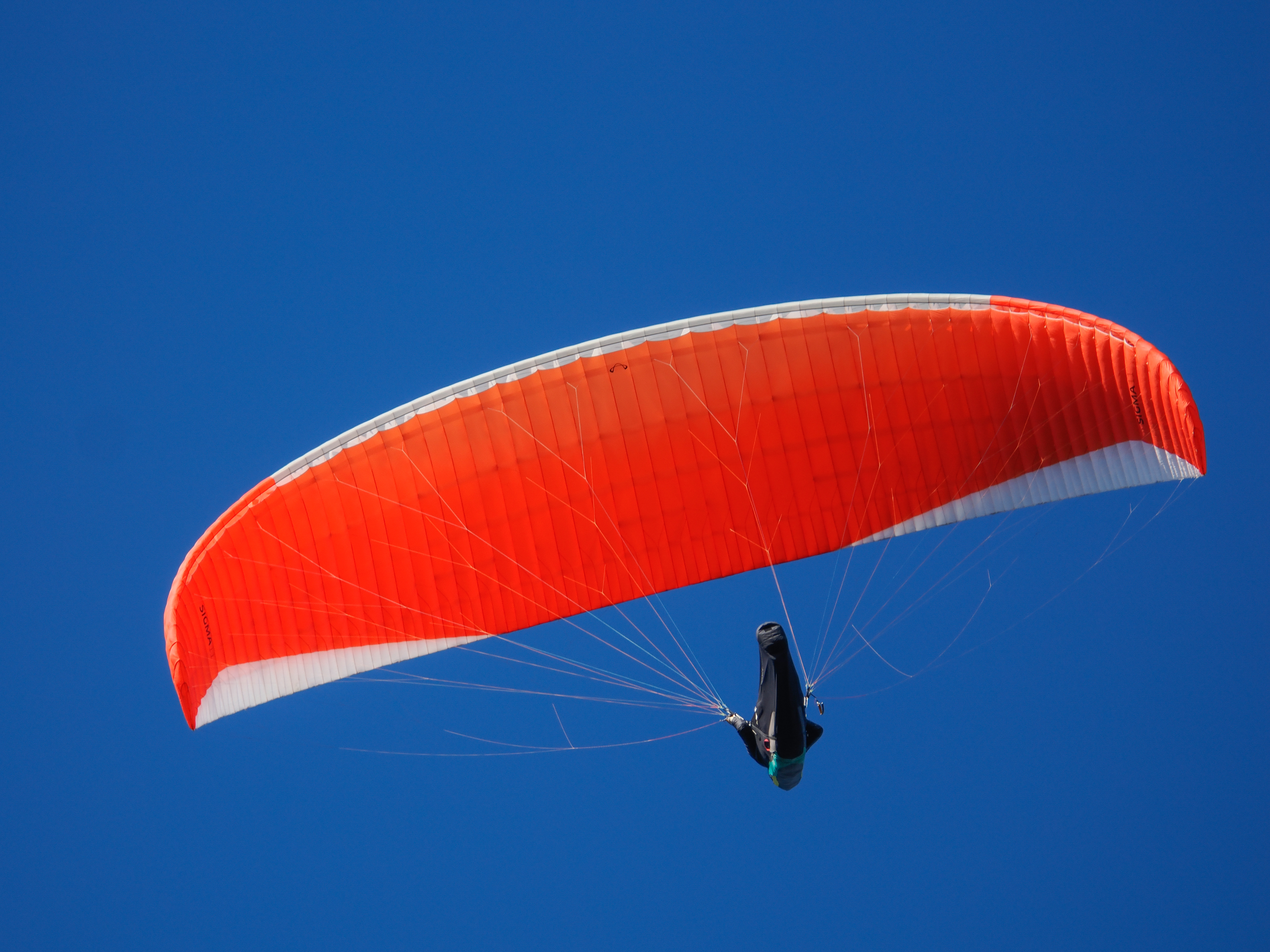

OM System M.Zuiko 150-600mm f/5.0-6.3 IS: Lab Data
We run a range of lab tests under controlled conditions, using the Imatest Master testing suite. Photos of test charts are taken across the range of apertures and zooms (where available), then analyzed for sharpness, distortion and chromatic aberrations.
We use Imatest SFR (spatial frequency response) charts and analysis software to plot lens resolution at the center of the image frame, corners and mid-point distances, across the range of aperture settings and, with zoom lenses, at four different focal lengths. The tests also measure distortion and color fringing (chromatic aberration).
Sharpness:
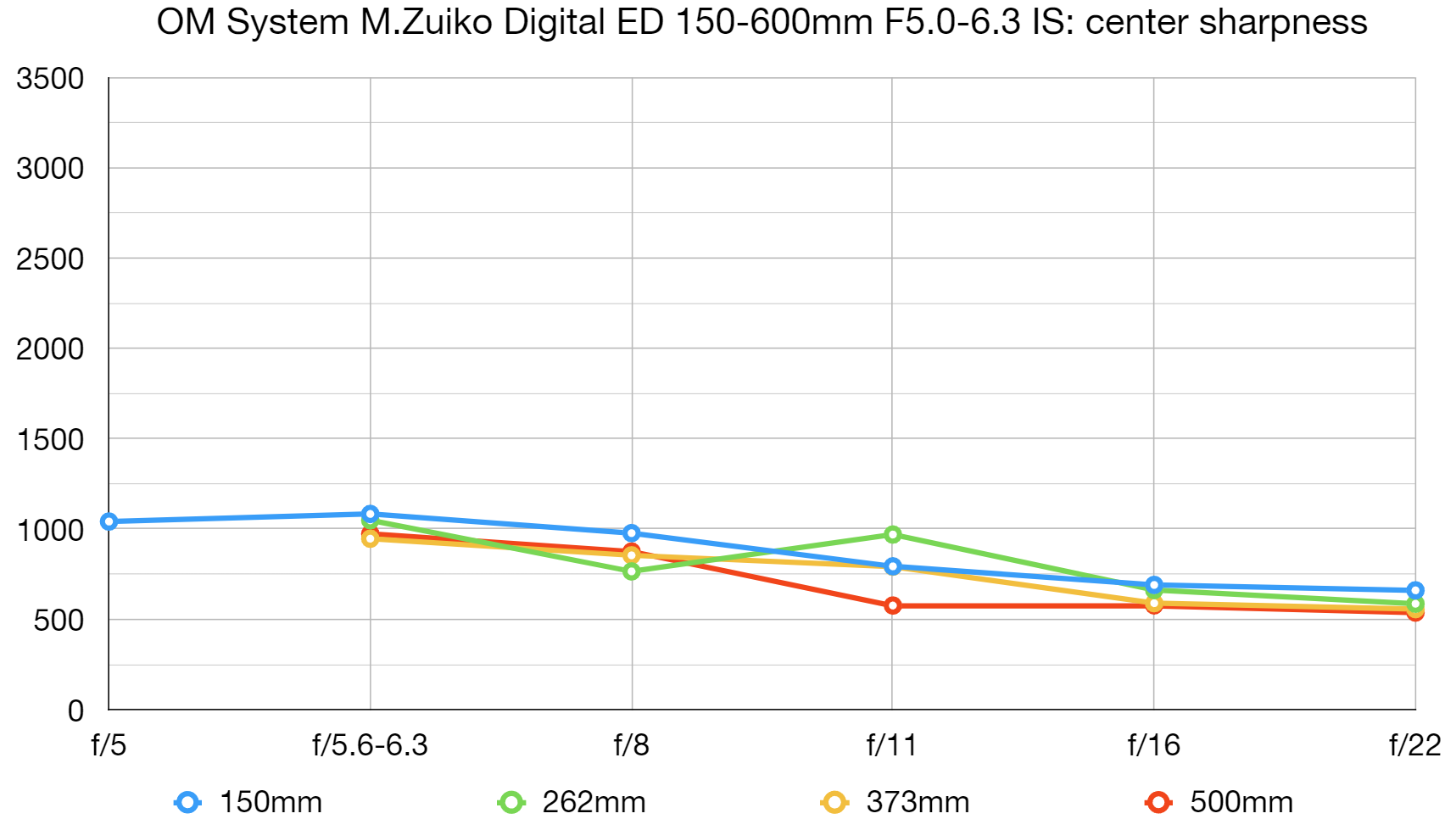
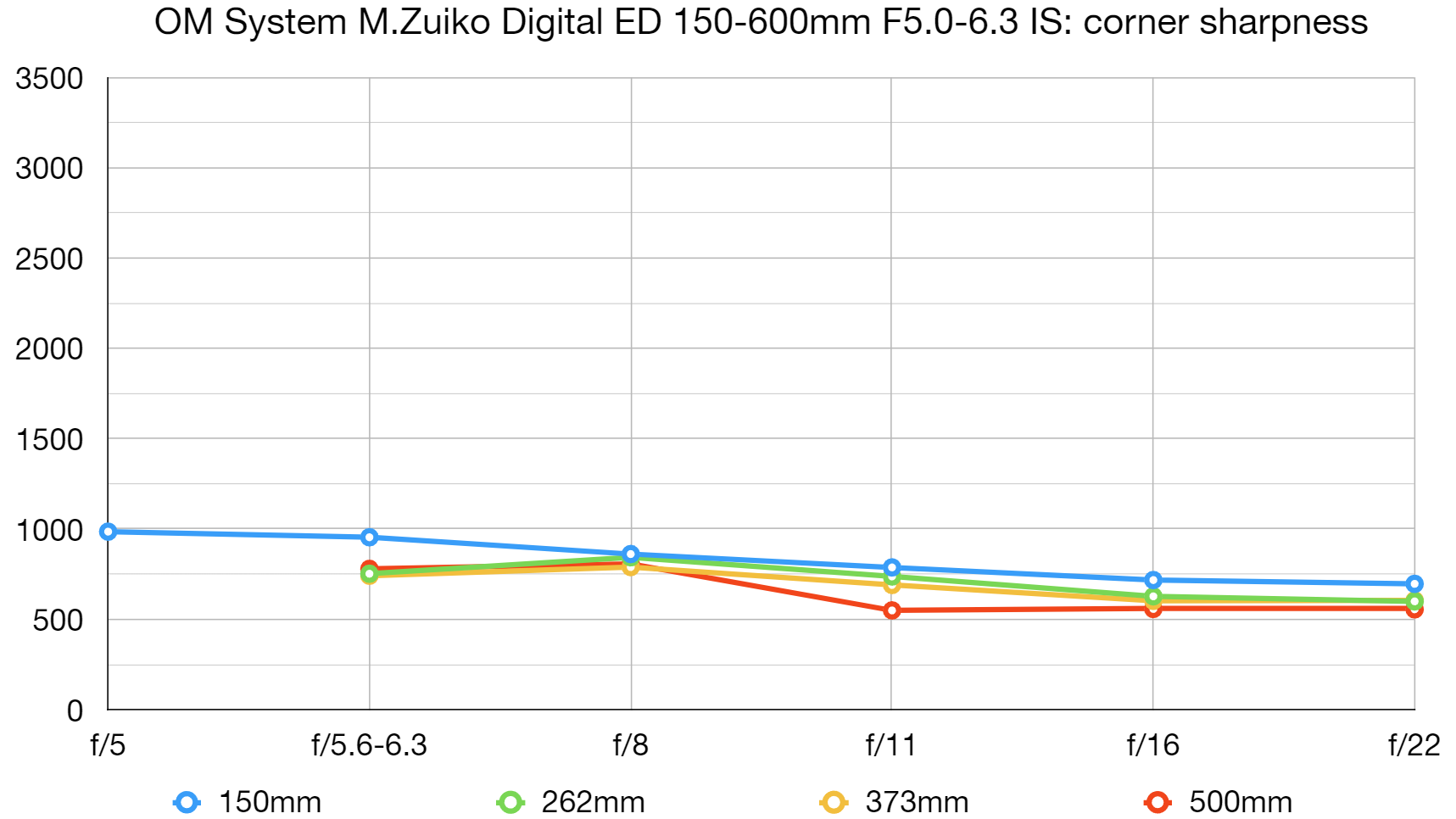
Firstly, you'll notice the longest focal length we could test here was 500mm. This is because the 2x crop factor of a Micro Four Thirds lens means we have to maintain twice the distance from our sharpness test chart compared to testing a full-frame lens of the same focal length. Consequently, even to test at 500mm required the lens to be positioned over 25 meters away from the test chart – and that's the entire length of our test facility.
Despite taking every possible precaution against camera shake, even the highest sharpness scores we could extract from the 150-600mm are mediocre at best. Sharpness is highest at larger apertures, and it does at least stay consistent across the entire width of the image frame, right into the corners. Sharpness is also consistent throughout our tested focal range. It's just a pit it's consistently disappointing.
Fringing:
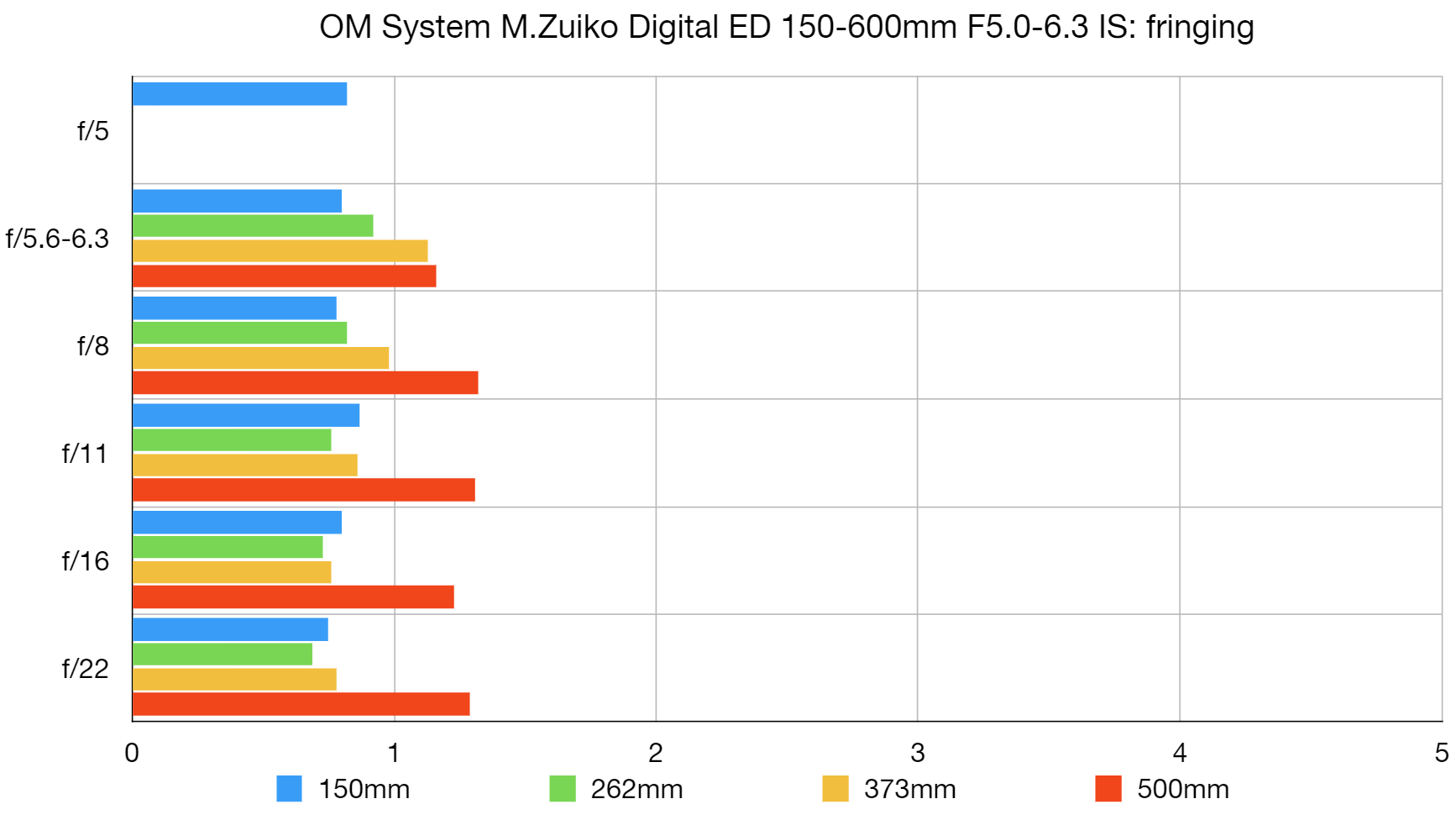
Color fringing is just about noticeable in the corners of frame, and you're most likely to see it at 500mm (and presumably beyond). It never becomes distractingly prominent though.
Distortion:
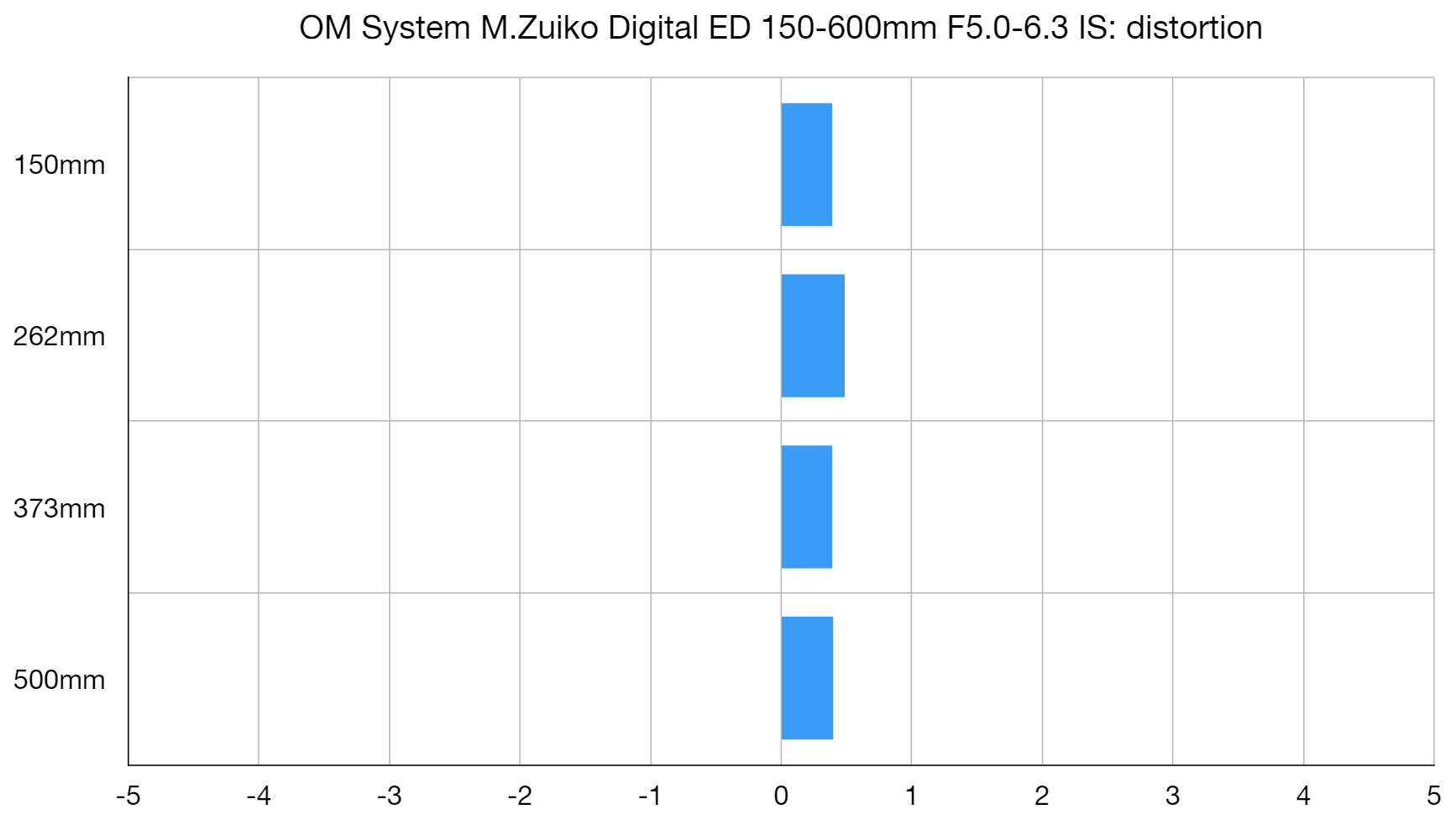
Thanks largely to automatic firmware distortion correction which cannot be disabled, the 150-600mm delivers near distortion-free image quality throughout the tested focal range.
OM System M.Zuiko 150-600mm f/5.0-6.3 IS: Verdict
The M.Zuiko Digital 100-400mm is a whole lot of fun to use because there’s just some much flexibility in its effective focal range of 200-800mm. The 150-600mm literally takes this a whole lot further – and beyond getting you much closer to subjects, it provides a lot more scope for experimenting with tighter framing and graphic compositions.
It takes a while to fully appreciate just what you can do in the ultra-telephoto range of 800mm to 1200mm, but you’re soon addicted to the possibilities. You can stay far enough away from skittish wildlife not to disturb anything and, with bigger birds and animals, you can get in tight enough for portraits. The surprisingly good close-up capabilities – especially at 150mm (300mm equivalent) – mean that smaller subjects are still reproduced at a good size in the frame.
Yes, it’s a heavy lens by OM System standards, but it does a lot of things very well, backed by an excellent optical performance… and you’ve seen what Canon’s RF 1200mm f/8.0 full frame prime ultra-telephoto looks like (and costs). In terms of all it can do, the OM System 150-600mm is neither especially bulky nor, for that matter, overly expensive. And the benefits will be plain to see after your first outing with it.
You might be interested in the best OM System / Olympus lenses, along with the best Micro Four Thirds lenses from all manufacturers.







